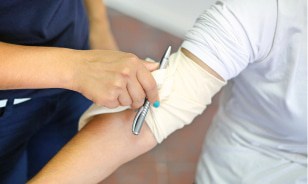If you need to use a tourniquet chances are you’re in an emergency situation and every second counts. You’ve exhausted all options, because when it comes to tourniquets, they are not the best option to stop bleeding but it will suffice when needed. Make sure you’re prepared and read about the correct method on how to use a tourniquet.
What is a Tourniquet?
A tourniquet is a tight band used to control bleeding by completely cutting off the blood flow of a wound. A tourniquet is a last resort, as it can cause irreparable tissue damage due to its extreme measures, remember you are trying to cut off blood flow, but if there is absolutely no other way to stop the bleeding, it can be an effective way to do so. If you have tried elevating the wound or if applying pressure is not an option or isn’t working, a tourniquet is the best solution.
How to Create a Tourniquet

Step by Step Guide on How to Apply a Tourniquet
- First, make sure you have full access to the wound. If it’s covered by clothing, remove the clothing. This will help you assess what is going on with the individual’s body. You will be able to see if blood is squirting rapidly or oozing slowly.
- You will have to position and tie the tourniquet above the wound. You have to tie the tourniquet around the injured limb several inches above the wound, in order to tie the part that is closest to the heart. If the wound is below a joint, you will need to tie the tourniquet right above the joint.
- Place the stick or rod on the knot, and tie the loose ends around it to make another knot. Twist the stick or rod to tighten the knot and increase the pressure on the wound. The bleeding should stop after this. Secure the rod or stick by tying it to the individual’s limb. Write the time the tourniquet was placed, to help the paramedics assess how to proceed.
Tourniquets should only be used on limbs and never anywhere else. Do not try using it on the neck, stomach, or back. Call 911 if a voluntary trip to the emergency room is not possible. Make sure that the individual is still breathing.
Taking Care of a Person After a Tourniquet Has Been Placed

You’ve done all the right things. You learned how to use a tourniquet, you’ve applied the tourniquet, you’ve called 911, and now you have to wait. This can be nerve-racking and seem endless. Here’s how to make sure that the person you are caring for makes it to the emergency room:
Check for symptoms of shock:
- Cold, pale, & clammy skin
- Blue tint to the skin
- Faintness
- Confused
- Shallow breathing
- He or she has lost consciousness
To alleviate these symptoms, lay the individual flat on his or her back. Provide them warmth in the form of blankets or body heat.
Where You Can Go To Seek Medical Attention
If you need immediate attention, call 911. Every second counts.
Stop at any of our 3 locations if you need to be treated for a deep wound. It is our sole duty to aid you in high risk situations. Our Clear Creek emergency room are ready to assist you at a moment’s notice. At Village Emergency Centers, we strive to provide you and your loved ones quality medical emergency care.
Our emergency centers are conveniently open 24/7 and accept walk-ins because we know emergencies are not events that can be planned. Get directions here to visit one of our locations.
